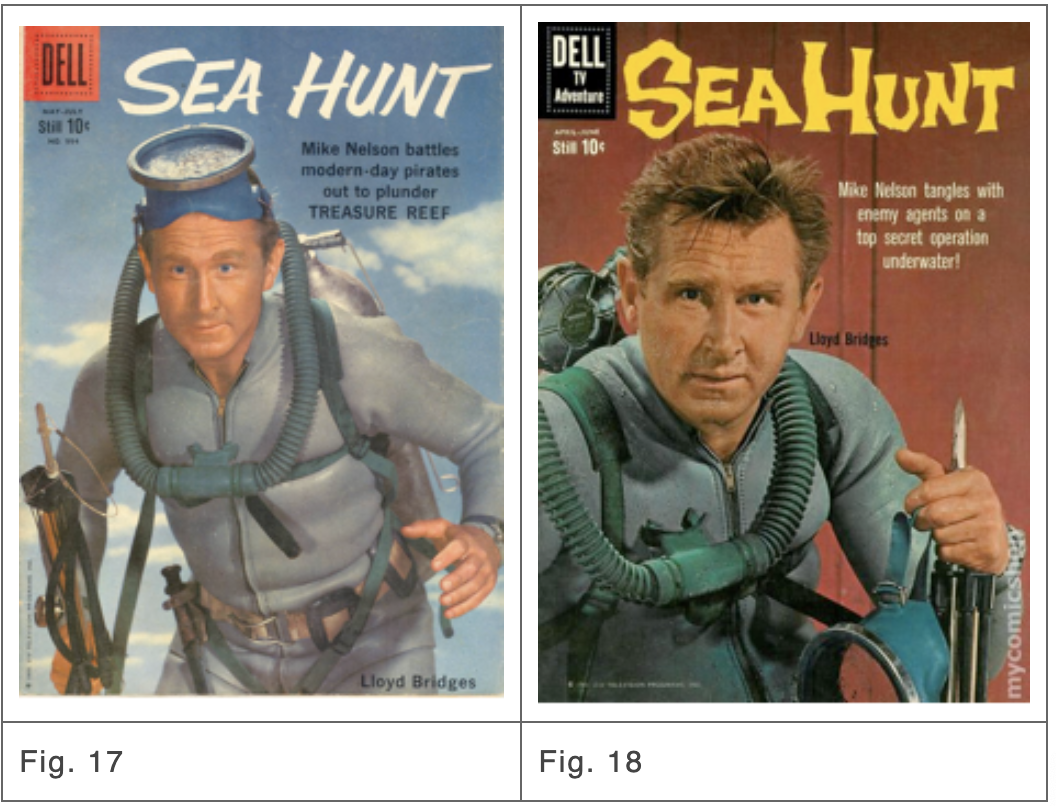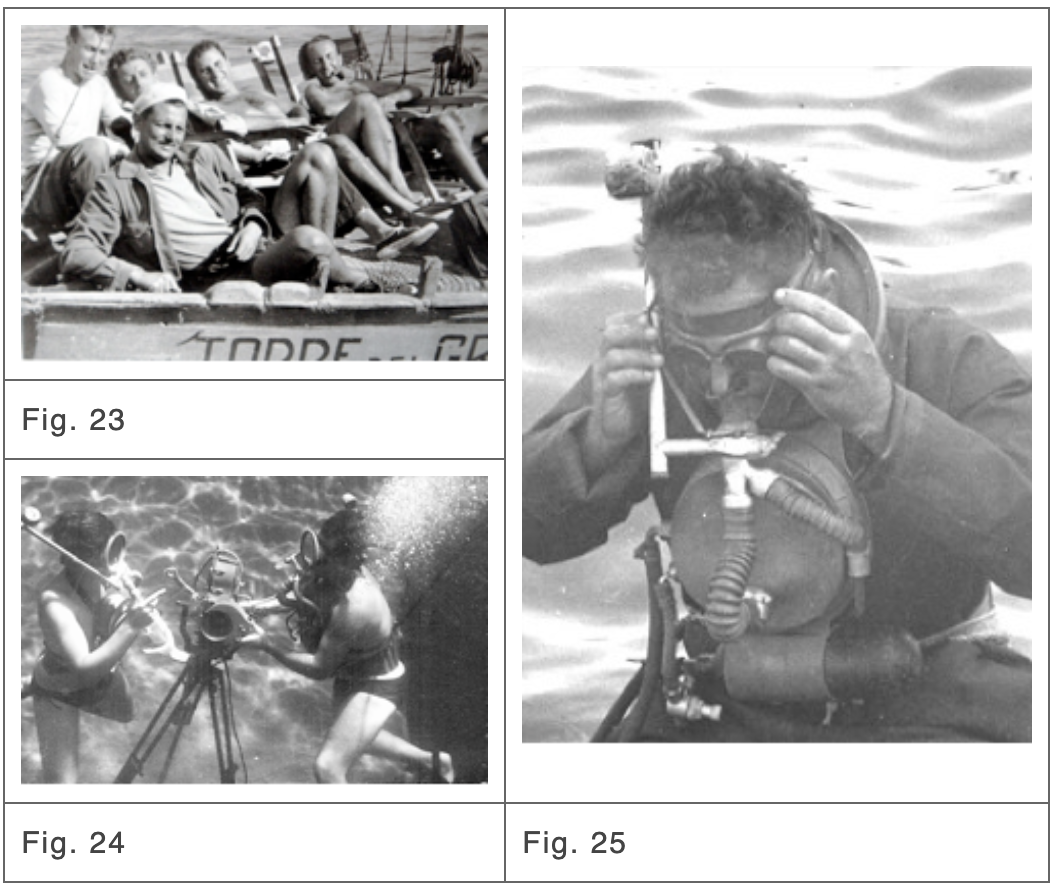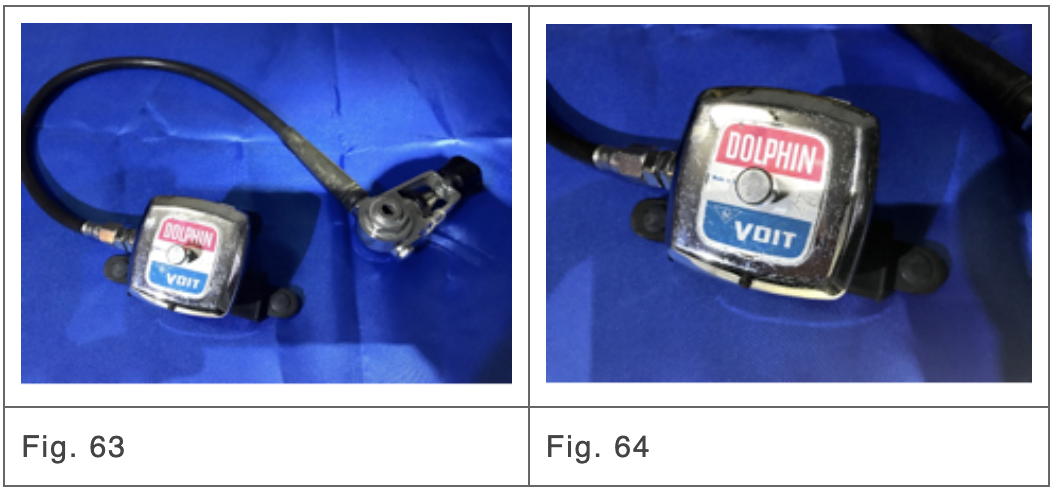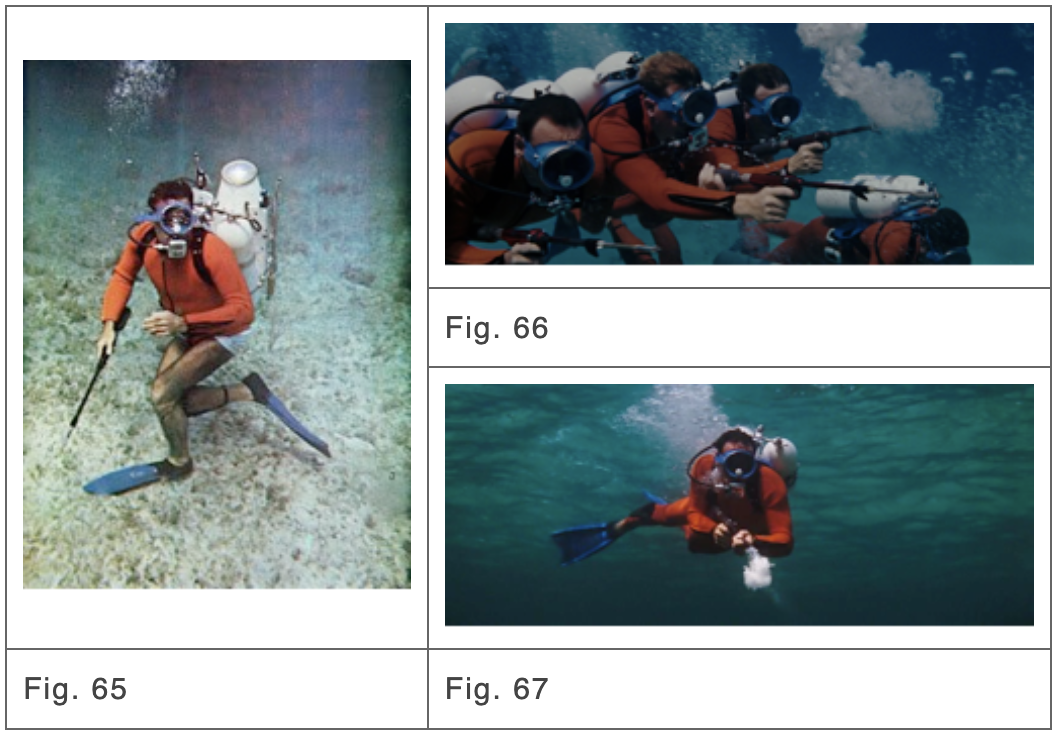Although “Cinema and Underwater Breathing Devices” looks a poorly understandable combination, in reality these two elements took advantages each other. The cinema indeed repeatedly used these devices in many underwater scenes from naturalistic documentaries and from action and adventure movies thrilling and involving the viewers thanks to the spectacular and fascinating of the underwater environments captured by the camera. These devices too, in particular the SCUBA equipment, could find the broad popularity reached nowadays thanks to the cinema that, with the involvement of millions of people all around the world, significantly contributed to the SCUBA diving development.
Running through the Self-Contained-Underwater-Breathing-Apparatus (SCUBA) history again from its birth to the end of the ’70 years, some cinema and TV movies produced in that period are presented in which the application of this device has been fundamental for the making of their main underwater scenes.
The debut of the SCUBA unit in the making of underwater movies and documentaries happened in 1943 with the work "Épaves"(Wrecks), the first movie-documentary by Jacques Y. Cousteau (Fig. 1) shoot in the waters of Bandol, close to Marseilles with French Navy colleagues and friends Frederic Dumas and Philippe Tailliez (Fig. 2 and Fig. 3).
The configuration of the SCUBA units used in those first submarine scenes was the prototypal one developed by the engineer Emile Gagnan, having the regulator main body still made in phenolic resin (see Fig. 4, 5, 6 and 7). Only from 1946 on the production version of the Cousteau-Gagnan regulator, called CG-45, would have had the main body made from drawn and chromium plated brass (Fig. 8 and Fig. 9).
After that European experience, in the old continent there were no other significant underwater cinema works with use of SCUBA units until the middle of the ’50 years. Meanwhile the Cousteau-Gagnan SCUBA unit was hardly trying to penetrate and diffuse on the European market literally destroyed by six years of war, in the USA the cinema would have been the main vehicle for the knowledge propagation of this new underwater sport and the related gear among the broad audience. The first important production along this path was “The Frogmen” in 1951, based upon the ventures of the U.S. Navy “gamma” special forces during the Second World War (Fig. 10). The SCUBA units used during the underwater scenes of that movie (see Fig. 11 and 12) were the first Aqua-Lung made in the USA by the U.S. Divers on license from La Spirotechnique and pretty identical to the CG-45 model (Fig. 13).
However the cinema production work to become a real classis for the North American diving enthusiasts was “Creature from the Black Lagoon”, an horror movie made in 1954 directed by Jack Arnold and interpreted by Richard Carlson and Julia Adams (Fig. 14).
For these underwater scenes as well, the U.S. Divers Aqua-Lung regulators were used, as shown in the pictures of Fig. 15 e 16. Since of the movie’s success, two sequels followed: The Revenge of the Creature in 1955 and The Creature Walks Among Us in 1956.
Since of the rapid growth of the North American SCUBA diving market in those years and perceiving the remarkable advertising and marketing possibilities offered by the cinema and by the TV towards the broad audience, several diving gear manufacturers and dealers stipulated contracts with film production companies in order to use exclusively their scuba gear products during the making of the underwater scenes of films or TV series.
In this sense the most followed and loved TV series in the USA certainly was “Sea Hunt” broadcasted from 1958 to 1961 through 155 episodes (Fig. 17 and Fig. 18). The protagonist was Mike Nelson, interpreted by the actor Lloyd Bridges, a former U.S. Navy frogman involved in countless adventures at the bottom of the sea. The Voit Rubber Corporation, who from 1955 had started manufacturing their SCUBA units under license from the U.S. Divers, produced a special version of regulator specifically for these TV series; this version was very showy and recognizable for its label, hoses and mouthpiece made in a bright green color.


These models (Fig. 19 and Fig. 20) were called VR-1 Mariner (single stage) and VR-2 Mariner (double stage). This TV series was so popular in the USA that still nowadays special rallies and events are organized with the participation of many fans of this character. During these events people dive using perfect copies or original restored units of the same gear used by the protagonist Mike Nelson (Fig. 21 and Fig. 22).

Despite the increasing popularity of the Cousteau-Gagnan SCUBA unit, the Italian cinema continued in using pretty exclusively the oxygen rebreather (A.R.O.) in the making of some films produced from the end of the ’40 years and the middle of the ’50 years. One of the pioneer of this glorious season of the Italian cinema certainly was the prince Francesco Alliata from Villafranca, a Sicilian noble who, together Quintino from Neaples, Renzo Avanzo and Pietro Moncada from Paternò (Fig. 23), his relatives and friends as well as belonging to the fallen nobility of the Two Sicily Kingdom, founded the Panaria Film. During the underwater shooting of the “Vulcano” film, produced by Panaria and recorded between Messina and the Vulcano isle in the summer of 1949, the prince Alliata himself took care of the whole underwater scenes using a strange rebreather specifically made by Salvas (Fig. 24 and Fig. 25). This unit was in fact very similar to an oxygen rebreather (A.R.O.) but could be fed with compressed air from the surface. This solution was considered the best one considering the difficulty in obtaining oxygen in those places very remote and poorly supplied at that time. This movie (Fig. 26, 27 and 28), launched in 1950 and interpreted by Anna Magnani, Rossano Brazzi and Geraldine Brooks under the direction of di William Dieterle, initially did not earn that success Panaria expected and practically was re-discovered and appreciated many years later.

The oxygen rebreather (A.R.O.) was the absolute protagonist of several movies, made in Italy in that period under Italian directors, inspired to the famous ventures carried out by the Italian Navy frogmen during the first phase of the Second World War, before the armistice on September 8th 1943. In the “I sette dell’Orsa Maggiore” (Hells Raiders of the Deep), a film with Eleonora Rossi Drago and Pierre Cressoy, produced in 1953 and directed by Duilio Coletti (Fig. 29), the main steps of the attacks to the Gibraltar English harbor by the famous “maiali” (Pigs), the human torpedo (Fig. 30) operating from the oil tanker “Olterra”, are shown. This ship (Fig. 31), moored and blocked in the Algeciras Spanish harbor from the beginning of the war, was transformed in secret to be the operating base for the Italian Navy frogmen and completely hidden to the English Navy forces who discovered the trick only after the end of the war.

The oxygen rebreather used in the underwater video shooting was produced by Salvas (Fig. 32 and Fig. 33) and, with the exception of the full face mask front glass shape, it was practically identical to the models manufactured by I.A.C. (Industria Articoli in Caucciù) before and later by Pirelli during the war. It is curious to note that some of the real protagonists of these military actions were involved as actors in the movie (Luigi Ferraro, Girolamo Manisco, Giovanni Tadini, Giorgio Spaccarelli). In fact the absolute dominance of the underwater vehicles and gear you can see in the submarine scenes could not have been reached without the direct involvement of the real players of those ventures.
The same A.R.O. Salvas, model, in its oxygen single tank version (Fig. 34 and Fig. 35), was used in the submarine video shooting of the movie “Africa Sotto i Mari” on 1953 (Fig. 36) with the splendid and nineteen at that time Sophia Loren, with the participation of Steve Barclay and directed by Giovanni Roccardi. Among the non-leading actors of this movie, Masino Manunza (Fig. 37) appeared as well. Masino was one of the most important diving camera-man of those years and also participated to the famous Italian Scientific Red Sea Expedition to be carried out between the end of 1952 and the summer of 1953. That experience would have brought Folco Quilici (Fig. 38) to celebrity with the documentary “Sesto Continente” (Fig. 39). Therefore, it looks not accidental that the story of that movie was somehow inspired to this expedition and that the main locations for the story and of the underwater scenes have been the same of Sesto Continente (the Dahlak Isles in Eritrea).

Although Quilici exclusively used the oxygen rebreather (A.R.O. ) during the submarine shooting of Sesto Continente (see the famous picture of Fig. 40 showing Quilici and Bucher during the preparation phase of the expedition at Ponza isle in the summer of 1952), the SCUBA regulator appeared during the underwater shooting phase of this documentary. This regulator was used both in its experimental versions produced by Salvas, the company who provided the whole diving gear necessary for the expedition (see Fig. 41 and 42), and through models derived from Coustea-Gagnan regulator. Thanks to the experience developed during this venture, starting from 1954 Salvas put in production the “Acquasub” model that was practically identical to the CG-45 with the exception of the rubber hoses (longer) and of the mouthpiece, provided with a surface-dive switching device and with a snorkel (Fig. 43).
Strangely the modern SCUBA unit inventor Jacques Y. Cousteau, after the 1943 debut with " Épaves" (Wreck), looked to be not more interested in repeating this first experience. But the great French oceanographer, who in the meantime had transformed an old minesweeper boat to an oceanographic vessel, the mythical Calypso, was preparing a great style return on the cinema and documentary scenes. Using the video shooting material recorded in about 10 years of submarine explorations, from the end of the Second World War to the middle of the ’50 years, on 1956 he produced the documentary-film “Le Monde du Silence” (Fig. 44 and Fig. 45). This work had a great success by winning in the same year the Golden Palm at the Cannes Festival di Cannes and the Academy Award Oscar as the best documentary the year later.

Since many scenes of that work are related to exploration campaigns carried out by Cousteau in the second half of the ’40 years, in most of the underwater shooting material the original CG-45 regulators installed on triple tanks can be seen. In other scenes, the CG-45, in its Aqua Lung versions distributed in the USA, can be observed (Fig. 46, 47, 48 and 49).
From this moment on the SCUBA unit becomes the unique protagonist of the underwater shooting activities and the glorious oxygen rebreather (A.R.O.) gets out of the scene forever replaced by the air regulator that was reaching a great popularity among the sport divers. The oxygen rebreather was used again but only in the underwater scenes of some films dedicated to the frogmen ventures during the Second World War. Among these we can remember “Mizar - Sabotaggio in Mare” on 1954 directed by Francesco De Robertis, and inspired to the heroic achievements of Luigi Ferraro at Mersina and Alessandretta. Another similar work was the “L’Affondamento della Valiant” on 1962 directed by Roy Ward Baker, running through the glorious ventures of the Italian human torpedo crews who, in the night between the 19th and the 20th December 1941, put out of order the English battleships Valiant and Queen Elizabeth in the Alexandria of Egypt harbor.


The air SCUBA unit, in its initial double hose version, stably appeared in all the underwater shooting of film and documentary in the ’50 years mainly in the American cinema productions.


In Europe the operating life of this device, in its most popular and widespread version “Mistral” before and “Royal Mistral” later, extended until the middle of the ’70 years as can be seen in the following pages.
After the submarine debut with the oxygen rebreather (A.R.O.) in the movie “Africa Sotto i Mari” on 1953, our splendid Sophia Loren repeated this experience in 1957, this time with the Aqua Lung, in the film “Boy on a Dolphin” (Fig. 50 and Fig. 51) produced by 20th Century Fox and directed by Jean Negulesco.


In this movie Fedra (Sophia Loren) a Greek young sponge collector, during a working dive finds a statue representing a boy riding a dolphin. From that time, despite the interest in purchasing the historical find from the tycoon Victor Parmalee (Clifton Webb), starts a relationship with Doctor Jim Calder (Alan Ladd), an American archaeologist interested in recovering the statue for the local museum. At the end he falls in love with her and they get married (Fig. 52 and Fig. 53).


We need waiting until the early part of the ’60 years to see the first single hose SCUBA regulators during the submarine shooting of films and documentaries.
One of the most famous TV production that attracted thousands of young people toward the sport diving all around the world has been certainly “Flipper” created by Jack Cowden and Ricou Browdning and broadcasted in the USA through 88 episodes from 1964 to 1967. These TV movies were inspired to the film “Flipper – The Fabulous Dolphin” produced in 1963 and directed by James B. Clark (Fig. 54, 55 and 56).

This TV series, settled down in the Florida, warm waters, showed underwater scenes interpreted by teenagers (Fig. 57 and Fig. 58) so suggesting the idea the sport diving could be accessible to everybody.

Among the different regulator models used during the video shooting of Flipper, definitely stands out the Calypso by the U.S. Divers. This regulator, launched on the US market starting from 1961, was one of the first double stages and single hose model having performances really competitive when compared with those of the double hose regulators which still dominated the market in those years. The first stage was of balanced diaphragm type and the second stage worked through a downstream valve directly activated. From this configuration, the next models were developed with better and better performances (Fig. 59 and Fig. 60).

A popular cinema character who widely used underwater scenes with highly dramatic and spectacular contents was James Bond, the famous United Kingdom Her Majesty “007 agent”, created by Ian Fleming. Among the episodes with extensive utilization of submarine scenes there was the movie “Agent 007 – Thunderball ” (Fig. 61 and Fig. 62), a 1965 production directed by Terence Young with Sean Connery, Claudine Auger and Adolfo Celi.
For this production as well, the Voit Rubber Corporation, in the same way followed at the end of the ’50 years with the TV series “Sea Hunt”, was capable of including a new regulator model, to be used as main scuba gear in the movie. We are talking about of the Dolphin, a single hose regulator with a diaphragm type first stage and a “downstream” directly actuated valve second stage (Fig. 63 and Fig. 64).
The typical square shape of this regulator, a bit ugly according to the aesthetic considerations of the modern divers, and its label with double red and blue colors, make it very visible in the underwater scenes of this movie (Fig. 65, 66 and 67). Despite the advertising dedicated to this regulator, looks like the commercial payback was not adequate compared with the investments done and therefore this model remained in production for few years only.
In the same year, the 1968, the great and unforgotten Bruno Vailati, famous TV documentaries maker, after having organized and coordinated the Italian Red Sea Scientific Expedition in 1953, was preparing another historical venture.


The idea was to dive and video shoot the Andrea Doria wreck, a passenger transport ship and Italian shipbuilding industry pride, sunk off Nantucket (Massachusetts) on July 26th 1956, after being spurred by the Swedish vessel Stockholm (Fig. 68 and Fig. 69).


The main difficulties of that expedition were the prohibitive environmental conditions of the sea bottom where the wreck laid with average depth around 70 meters, very strong currents, water temperatures between 4 and 6 degrees Celsius and poor visibility. In addition to those environmental conditions they had to take care of the sharks, mainly blue and mako sharks, frequenting in great number those places and still very aggressive. Everything with the sport diving gear available at those times (SCUBA unit, dry suits, pneumatic decompression meter). The diving team accomplishing that expedition, made by a total of 21 dives on the wreck carried out during July 1968 included, in addition to Vailati himself, also Stefano Carletti and Al Giddings (Fig. 70, 71, 72 e 73).

The video shooting material recorded during the expedition was used by Vailati for the making of the documentary “Andrea Doria – 74” (Fig. 74) that was and remained a true cult for the Italian divers. These are still impressed by the great capabilities and skills shown in those extreme conditions and with that gear, far away from the modern one in terms of performances and comfort. Stefano Carletti as well wanted documenting his experience during the expedition by writing the homonymous book “Andrea Doria -74” (Fig. 75), with copies pretty difficult to find nowadays.

The battle-horse of the Andrea Doria’s team was the “Royal Mistral”, a famous single stage regulator manufactured by La Spirotechnique starting from 1963 and until the end of the ’70 years (Fig. 76 and Fig. 77).

This is perhaps the last time a double hose regulator was used during the underwater shooting of documentaries and movies. In fact, in the next cinematographic productions the single hose regulator becomes the absolute protagonist, like in the very famous “Jaws” (The Shark in the Italian version) on 1975, directed by Steven Spielberg (Fig. 78 and 79).

In the few submarine scenes of the last part of the movie, where the three main characters Martin Brody (Roy Scheider), Quint (Robert Shaw) and Matt Hooper (Richard Dreyfuss) fight the decisive battle with the gigantic white shark, the marine biologist Matt Hooper, entering the anti-shark cage equipped with a strychnine tipped harpoon, uses a U. S. Divers SCUBA unit made by an aluminum single tank and by a Calypso IV regulator model (Fig. 80, 81, 82 and 83).
We close the review of the movies containing underwater action scenes with “The Deep” (Abissi in the Italian version) on 1977 directed by Peter Yates and interpreted by Nick Nolte, Robert Shaw and Jacqueline Bisset (Fig. 84 and Fig. 85).
In addition of the strange and rare M300 Micro regulator model used by the splendid Jacqueline Bisset and manufactured by the French company Piel (Fig. 86 and Fig. 87), the most shown model in the movie, because used by the male protagonist, is the Italian Spinnaker A manufactured by GSD from Avegno (GE) (Fig. 88 and Fig. 89).

Here our review of the couples movies/documentaries and the related underwater breathing devices used in those works ends. We are almost at the end of the ’70 years and the sport diving is entering its mature life phase with reliable gear and consolidated technical solutions and with divers fully aware and trained through solid and effective training organizations. In the following years and until nowadays as well the underwater shooting continued to be fundamental in the making of many action movies and naturalistic documentary. However, the charm and the emotions of that first pioneering phase of cinema and TV, with its great protagonists and its gear, sometime ingenious and often rudimental, can’t be repeated anymore.



_______________